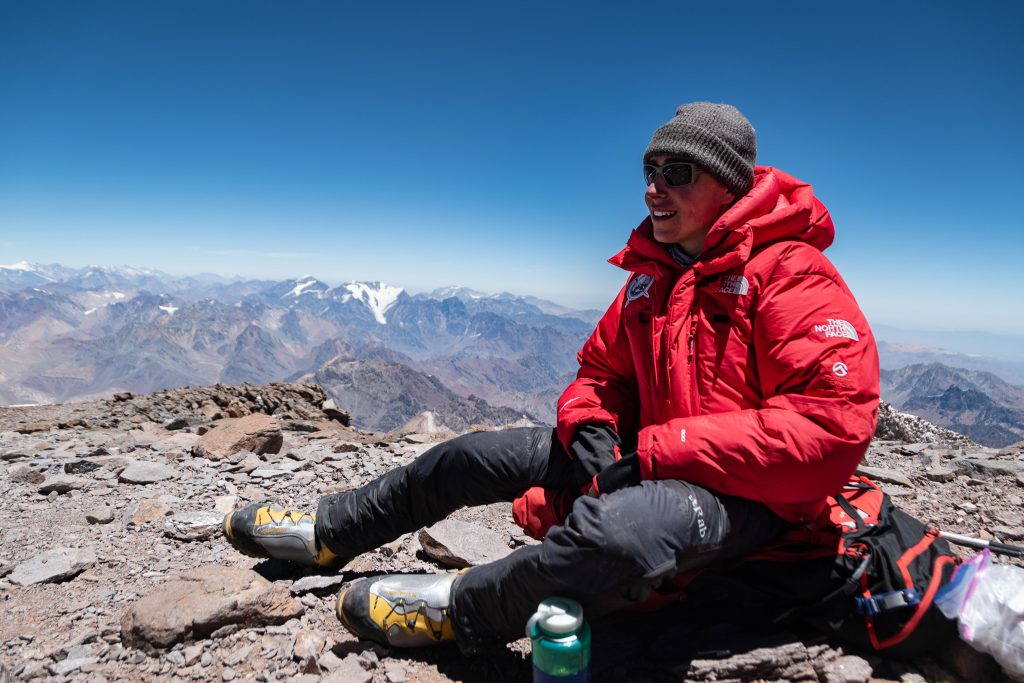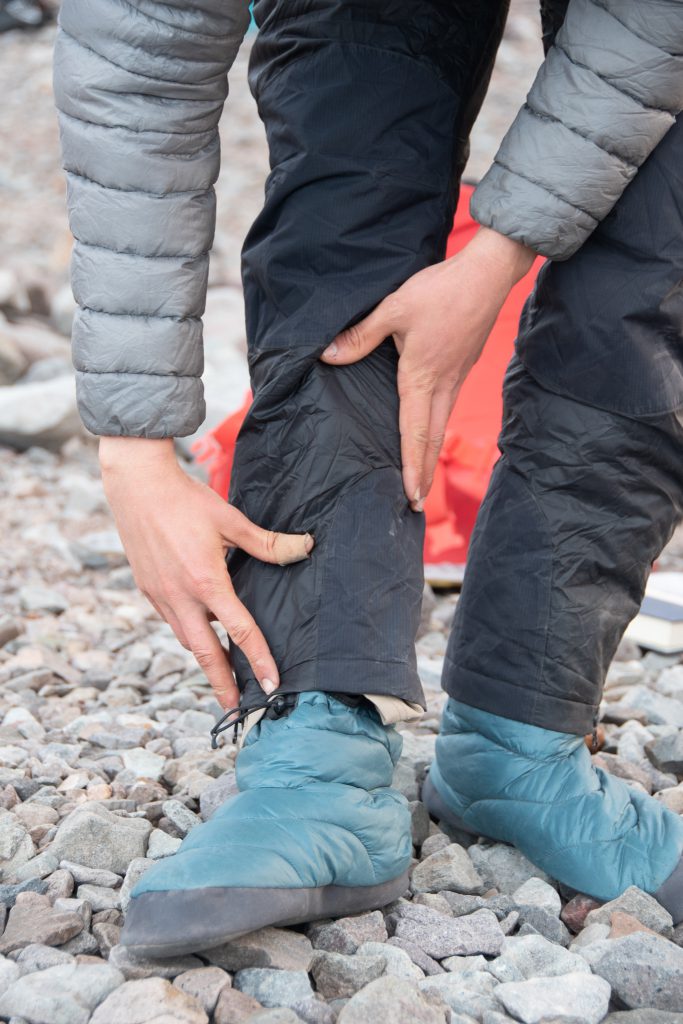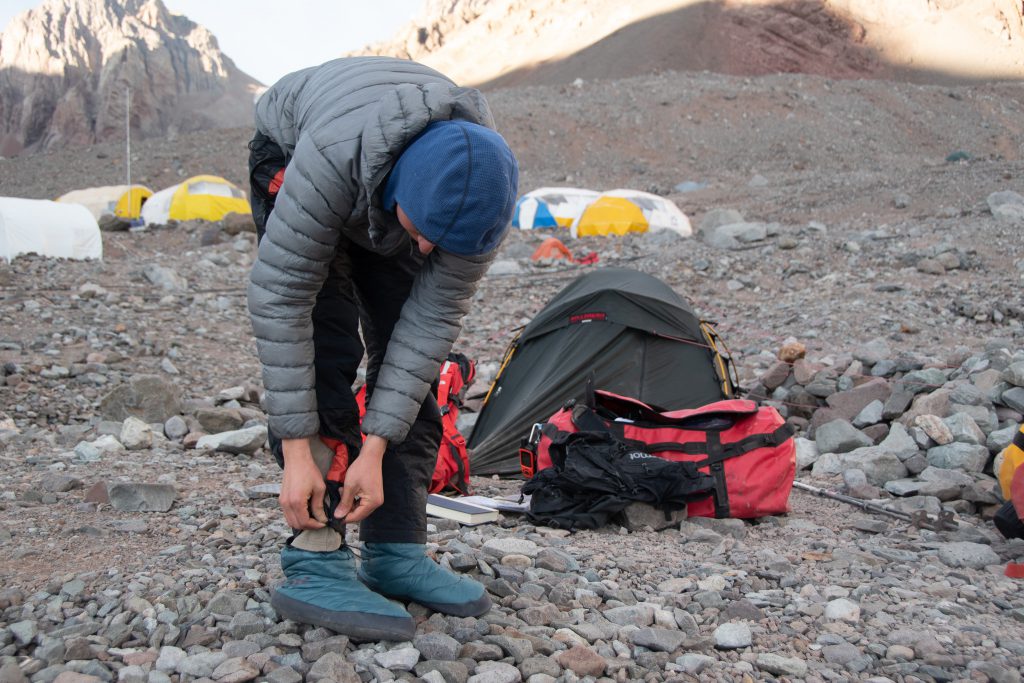ProView – Rab Photon Pants
For two weeks I brought the Rab Photon pants to South America’s tallest peak: Aconcagua. At 22,841’, it is the tallest peak outside the Himalaya. The mountain is large and has a wide variety of environmental conditions. At lower elevations on the trek to basecamp, it is HOT; temperatures can reach as high as 85 or 90 degrees Fahrenheit near the entrance to the park. Up near 20,000’ though, it is polar; temperatures on the summit, with the wind chill, can dip below -20 F.
Rab Photon Pants

Product Description: Made with a tough Pertex® Quantum outer fabric and lining, the Photon Pants feature additional Pertex® Shield 2.5 layer reinforcement patches on the seat, knees and kick patches for added durability in high wear areas. 100g/m² of Stratus™ recycled insulation will you warm even in extreme cold. Full-length side zips ensure the Photon Pants are easy to put on or take off over mountaineering boots, and can also be used for ventilation. The included stuff sack makes them easy to stash away until needed. Designed to endure the rigours of expeditions, the Photon Pants are the ideal high mountain pant for use in extreme cold.
Offer price: $200 MSRP
-
Quality
(5)
-
Features
(5)
-
Fit
(5)
-
Durability
(5)
-
Friendliness to the Earth
(5)
Summary
I am in love with the Rab Photon pant; I might even wear them around the house they are that cozy. In the alpine, they perform beautifully: lightweight, wind-resistant, repel water splashes, and have great features including deep pockets and strategically placed zippers. They are durable and reinforced in areas of high wear and slip on easily over other layers.
Overall
5Pros
- True to size
- Packable
- Warm-for-weight
- Packs down small and includes a stuff sack
- Tough, abrasion-resistant Pertex outer
- Full-zip design allows for easy removal
- Deep pockets
Cons
- No cons that I could find or think of during my test. I LOVE these pants and intend to take them on many more cold adventures.

For this expedition, I needed clothing that was lightweight and packable, but most importantly, warm. I would be spending multiple days at higher camps acclimatizing, sitting idle, and I would need clothing to keep me warm during these times. Cold is one of the fastest ways the body loses energy, burning up valuable calories just to stay warm.
On Aconcagua, the wind is the fiercest element, consistently above 50 mph. Only for brief periods of time does the wind ease and allow climbers to reach the summit. Not only would I need warm clothing, but I would need wind-cutting layers as well.

Fit/Comfort
A warm hug is the simplest way to describe the feeling of putting on the Photon pants for the first time. The Photon pants are lined with Pertex Quantum and filled with 100 g/m^2 of Stratus recycled insulation, so they both feel incredibly comfortable and are amazingly warm for their weight.
In terms of fit, I was pleasantly surprised at how well I fit into the size Medium pants. Normally I struggle to fit into “sized’ (S/M/L) pants, rather than pants with a waist and inseam length. I stand 6’2’’ but have a 31/32 inch waist, so normally I need a longer inseam and slimmer waist. The size Medium Photon pants fit perfectly, though, especially with mountaineering boots on. They were not too short that they felt like “floods”, but also not too long that they were dragging against the ground or interfering with my boots.


Look/Style
The Rab Photon pants have a simple look: clean lines with little distractions. For the most part, they are one solid color; the reinforcement material on the knees shows slightly, but other than that, they appear to be a simple pant. On the mountain, in puffy clothes and other technical equipment, the Rab Photon fits right into the “mountain uniform.”

Features
The best part of the Rab Photon pants is the zipper design. The pant includes a full-length zipper design that allows for both removal and added ventilation without having to take off your boots. When temperatures are frigid and you are moving up the mountain, this is an incredible luxury, if not a necessity. The top and bottom of the zipper feature clips that allow for added security, ensuring that the pants do not fall off if you have them zipped open.
Additionally, the Photon pant has deep pockets that can easily fit a cell phone, camera battery or two, granola or protein bar, headlamp, etc. I appreciated having these pockets on the summit climb, as I stashed my phone in the pocket so it could stay warm and close to my body. I barely noticed the presence of the phone as well. The pockets include a zipper closure, so what you put in won’t fall out.



Weight/Packability
At 19 ounces total packed weight, the Rab Photon are incredibly light for their warmth, and with a dedicated stuff sack, pack down small for volume and weight-conscious missions. The Rab Photon disappeared into my XXL North Face duffel bag, along with other gear, exactly what I needed for a long, expedition-style climb like Aconcagua. For similar-style climbs like Denali, Everest, and other base-camp missions, the Rab Photon will pack down small and require minimal space and weight.

Function/Performance
On summit morning, I zipped up the Rab Photon and headed on up the mountain, and they performed beautifully. In the pre-dawn cold they kept my lower body warm and loose; once the sun began to peak over the horizon, I partially unzipped the legs for added ventilation. Functionally, I was able to adapt with the Rab Photon to a variety of conditions: high wind, low wind, severe cold, intense sun.

Durability/Construction
The Rab Photon pants are reinforced in areas of high wear: on the knees, the inner foot (for crampons), and on the “seat” (butt). The abrasion resistance of the Pertex Quantum outer is impressive; even when slipping or dragging across the rocky ground or when sliding out of the tent, the Photon never snagged, tore, ripped, or even got caught. I am notoriously rough on my gear, but the Rab Photon pants are strong enough to withstand even my abuse.
Additionally, the Rab Photon pants are filled with recycled Stratus insulation, not feathers, and I did not once notice any insulation leaking from seams.
Friendliness to the Earth
Rab prides itself on its sustainability and is very conscious of its environmental impact, as is evident in the construction of the Photon pants. The Rab Photon pants are filled with 100% recycled polyester Stratus insulation, just one of the many ways that Rab goes the extra mile to ensure its environmental responsibility and sustainability:
Per Rab’s website:
- “In line with the legislation, we only use fluorocarbon-free DWRs or shorter chain PFCs (C6) DWRs, but we are committed to removing these from our products.” Rab realizes that DWR coatings and PFCs are environmentally harmful, and is dedicating resources to research alternatives.
- Rab is a member of the “Microfibre Consortium an industry led body which aims to address the microfibre challenge though activities in strategy, integrity, research, and product development.”
- Rab follows the “Responsible Down Standard”, ensuring that “every stage from farm to factory is certified by the Responsible Down Standard (RDS).”


The Final Word
I am in love with the Rab Photon pant; I might even wear them around the house they are that cozy. In the alpine, they perform beautifully: lightweight, wind-resistant, repel water splashes, and have great features including deep pockets and strategically placed zippers. They are durable and reinforced in areas of high wear and slip on easily over other layers.
Rab has been trusted by dedicated alpinists for years because of their craftsmanship and high-quality products, and the Photon is certainly one of them. The best part: Rab is a company that you can be proud to support. They are environmentally conscious and are constantly searching for ways they can reduce their environmental impacts.
Shop the Rab Photon Pants on Outdoor Prolink. Not a member? Apply today!

About the Gear Tester

Sam Chaneles
Sam Chaneles is an avid mountaineer and backpacker, climbing peaks in the Cascades, Mexico, Ecuador, and Africa, as well as hiking the John Muir Trail and off-trail routes in Colorado. He has climbed peaks such as Aconcagua, Mt. Rainier, Cotopaxi, Chimborazo, Kilimanjaro, and many more. Sam graduated with a B.S. in Mechanical Engineering from Georgia Tech. During his time there he was a Trip and Expedition Leader for the school’s Outdoor Recreation program (ORGT). He has led expeditions to New Zealand, Alaska, Corsica, France, and throughout the United States. Sam is based in Issaquah, WA just outside of the Cascade Mountains. You can follow Sam and his adventures on Instagram at @samchaneles, or on his website at www.engineeredforadventure.com.












Thank you for the review!
A couple of questions you don’t mind:
1. How many layers were you wearing under these pants?
2. What was the coldest temperature when you was wearing the pants?
3. How would these pants plus a base layer fare at camp under -15C? Would they be warm enough?
I’m looking for insulated pants which would keep warm even when I’m standing still and the temperature like -15C or even colder.
Hey Andrey! Thanks for commenting.
We’ll have to differ to Sam for your questions. We’ll let him know so he can share his thoughts with you.
Audrey,
1. How many layers were you wearing under these pants?
I was wearing a midweight (200 weight) thermal baselayer from Under Armour (ColdGear 2.0), and Outdoor Research Cirque softshell pants.
2. What was the coldest temperature when you was wearing the pants?
The air temperatures were around 0-5 degrees F, which translates to -18 to -15 degrees C.
3. How would these pants plus a base layer fare at camp under -15C? Would they be warm enough?
With a layering system similar to what I used, I absolutely think these would be warm enough. I think the biggest thing is if you will be getting wet or not. If you anticipate heavy precipitation and snowfall I’d pair these with a hardshell pant as a vapor barrier.
Hope this helps! Feel free to reach out with more questions.
I’m looking for insulated pants which would keep warm even when I’m standing still and the temperature like -15C or even colder.